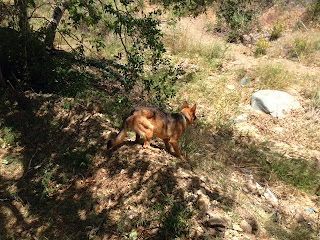Back in the day (i.e. the Crusades), people would keep their horses in pasture and let them eat all day, as is natural for horses. They are, after all, grazing animals that are meant to eat and walk constantly. Well if your horses our outside the city walls, they are prone to getting stolen in battle or by thieves, especially prized horses. Hence, people brought them inside, made them live in stalls, and nailed shoes to their feet to keep their now rotting feet "sound." The best thing for horses is grass (surprise surprise ;), but since grass doesn't grow year round here, people use hay.
There are many varieties of hay, for horses, these consist mainly of two categories: grass and legumes. Legumes are alfalfa and clover, with grass hays being timothy, orchard, and burmuda. I read endurance blogs where these people ride 50-100 miles, so they know a thing or two about horse health. After all, an unhealthy or unsound horse can't make it 100 miles and pass a mandatory vet check. On these blogs, they mentioned their horses' nutritional intake, typically grass hays. Alfalfa can give excess energy and is very high in calcium, but has a high nutrient profile. Alfalfa hay is good for young horses or lactating mares, so I don't mind that it's a primary feed for Calvin. However, I wish he could get a nice mix, as it's being shown that having a variety of hay is actually what's best, no surprise there.
People today still view stalls and horseshoes as "norm," but many people are catching on that it's more natural and horses stay healthier in pasture eating grass all day. Research has started to show that 80% of horses have ulcers, much of which can be prevented by free-feeding as nature intended. Ideally, I'd like Calvin to have a large grass pasture where he can snack all day. My second choice would be to leave hay-nets (see picture below) or a slow-feeder out to where he can eat whatever hay he wants all day. However, reality is that Calvin stays in pasture with 2 other mares and they all get fed alfalfa cubes 2x per day. I can't put extra food up because the mares won't let him near it, not to mention that I doubt the owners would want their fat girls fed extra. I've tried to switch him into a pasture by himself or one where they free-feed horses, but it's not possible currently as there isn't space. The only other option is to free feed him in a stall, but I don't want to take him out of pasture. So I hope something opens up soon.
So blog readers, here is my plight. I try to do what's best for my boy, but it's so difficult when you don't have control over where to keep him. Where I'm located, there aren't any options to keep him in a large space with ample food unless you own your own horse-property, or are willing to pay a huge premium in board. While there are insanely expensive horses where I live, their owners still believe that keeping a horse confined to a 12x12 is the best option to protect their "investment."
Since there aren't any other options, what I'm doing now is feeding him grass hay and beet pulp where I tie him for grooming and tacking up. I'm hoping that this extra feeding a few times a week makes a difference...at least he enjoys it. Hoping for greener pastures in the future! ;)
Calvin trying to figure out how to get the hay out of this hay net. This is burmuda hay; he was a happy boy!
For more reading on hay, this is a great article.







